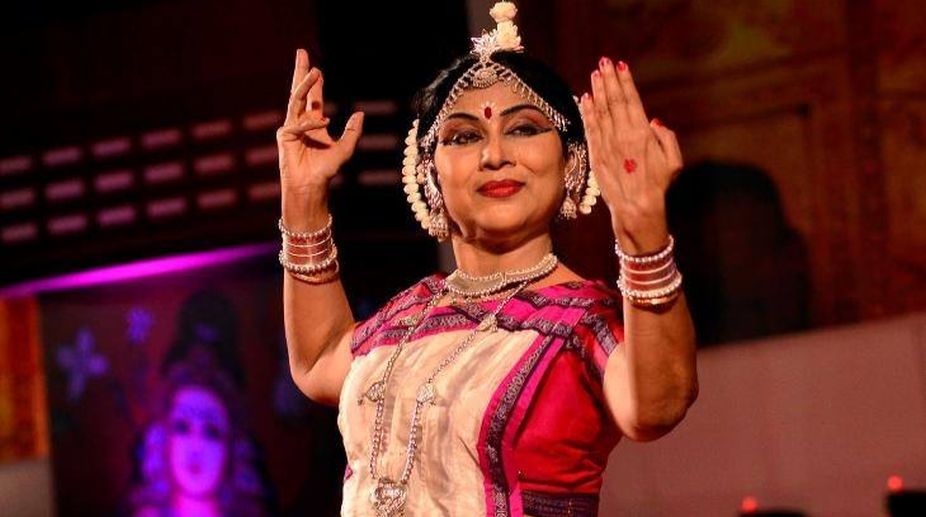Guinness World Record of ‘Classical Dance Relay Marathon’ in MP
Officials of the Guinness Records handed over the certificate of the world record to Madhya Pradesh Chief Minister Dr Mohan Yadav at the festival on Thursday evening.

(Photo: Facebook)
With Shinjan Nrityalaya each and every occasion becomes a grand one. So it was with their annual show at Rabindra Sadan, Kolkata. The highlight of this year’s annual was Shinjan Nrityalaya’s new production Surya or the sun — a much venerated God — performed by their repertory members. The journey of its students from scratch to highly refined performers, well equipped with all the nuances of the form, was there for all to see. Apart from the seniors there were other groups too, who would be ready to take over and make their mentor proud.
Shinjan Nrityalaya is a big name in Kolkata, imparting classical Odissi dance of the Guru Kelucharan style whose direct disciple is its artistic director Aloka Kanungo. She has earned much fame as a recipient of the Central Sangeet Natak Akademi Award in the recent past. Surya, scripted by reputed Sanskrit scholar Nityananda Misra, has been a very popular topic for Indian classical dancers of all forms. Surya is a solar deity in Sanathan Dharma and his is iconography sees him riding a chariot drawn by seven horses representing the seven colours of the rainbow. He is one of the nine planets in the zodiac system. He has been worshipped right from the beginning of civilisation when human beings prayed to nature gods. Even today, his followers chant the Gayatri Mantra when he ushers in dawn from the eastern horizon and bids him farewell with Sandhya Arati. He challenges darkness and is the source of energy, warmth and light.
Advertisement
Mythology portrays many stories about the sun god. The morning sun is a red ball with soft rays. Gradually at midday when it is overhead, the temperature rises when it spreads its brightness all around. Then it retires in the evening with an assurance to rise the next day. During rain its rays capture the seven colours — violet, dark blue, blue, green, yellow, orange and red.
Advertisement
All these details and characteristics were captured with great artistry in the compositions and executed poetically by the performers. The scene enacting the appearance of the sun driven by horses — where performers moved in unison — with devotees paying obeisance was magnificent. Some of the formations such as rain cloud formation in the sky and the appearance of the rainbow were eye-catching. Kanungo was assisted in choreographing Surya by her well-trained disciples Arpita Venkatesh and Baishali Kolay, the music of which was composed by Laxmikanta Palit. Dinesh Poddar who is a lighting wizard lit up each and every scene appropriately. Compere Urmila Bhowmick facilitated comprehension of the sequences in a fitting manner.
With the choreography of Surya, Kanungo did even better than her best. Her other nuanced choreographic work, which this reviewer had the chance to see recently was Dasam Mahavidya about the different manifestations of Devi Durga. It was a neat production with perfect Odissi dance movements, expressive facial expressions and angabhinaya. The performers were clad significantly in crimson-coloured Odissi costumes evoking awe at the different qualities of Durga. The concept of Durga was suitably personified and aesthetically presented. Dasam Mahavidya was an excellent production, which is comparable with the very best.
The junior aspirants of Shinjan Nrityalaya are well on their way to maturing as dancers with supple bodies who are at ease with all movements. For that reason Kanungo exposed them to a workshop by Gotipua veteran Lazmikant Swain to teach them three pieces. During a summer workshop organised by Shinjan Nrityalaya, her students learnt Panchadevata Stuti, Badya Pallavi and Bandha Nritya in Gotipua style. These were performed in this festival of dance, much to the appreciation of all.
Along with toeing the line of modernisation and innovation, Shinjan Nrityalaya has always valued tradition. Kanungo has toiled hard to support and revive Bandha Nritya — an acrobatic part of Odissi dance — and is deeply committed to restoring it as a part of the Odissi repertoire.
The repertoire members Arpita Venkatesh, Baishali Kolay, Nivedita Daw and Sriparna Bose presented Taal Madhuri. The traditional arasas in three-time repetitive bols (tihais) featured in this piece, accompanied by a sthayee badya. It was a special production of Kanungo, the music for which was composed by Guru Kalandi Parida and Himansu Swain. It was an innovative number in the parameters of tradition.
The popular piece Dasavatar as composed by Guru Kelucharan Mohapatra has been performed time and again without losing its charm. It found its pride of place here. Kanungo’s disciples who excelled were Apita Venkatesh, a visiting dance mentor at Rabindra Bharati University; Baishali Kolay, Sriparna Bose, Nivedita Daw, Debarati Goswami, Shampa Banerjee ( all senior national scholarship holders) and Asmita Mohanty, Debesee Sen and Urjjasee Basak (recipients of junior national scholarships from CCRT). Established in 1996, this was the 21st year of Shinjan Nrityalaya’s celebrations. They started their annual programme in 1997.
Advertisement
Officials of the Guinness Records handed over the certificate of the world record to Madhya Pradesh Chief Minister Dr Mohan Yadav at the festival on Thursday evening.
The capital city witnessed an enchanting evening of classical dance at Samasrava, organised by Manasija, a non-profit dedicated to promoting Indian art and culture, recently.
The Angikam Foundation presented their Mahotsav at Gyan Manch on 15 June 2024. Financially, the Mahotsav was supported by the Ministry of Culture, Government of India.
Advertisement
